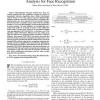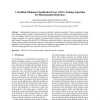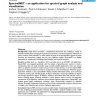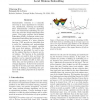TSMC
2008
13 years 11 months ago
2008
Abstract--Dimensionality reduction methods have been successfully employed for face recognition. Among the various dimensionality reduction algorithms, linear (Fisher) discriminant...
PAMI
2007
13 years 11 months ago
2007
—Over the past few decades, a large family of algorithms—supervised or unsupervised; stemming from statistics or geometry theory—has been designed to provide different soluti...
VLSISP
2002
13 years 11 months ago
2002
Dimensionality reduction is an important problem in pattern recognition. There is a tendency of using more and more features to improve the performance of classifiers. However, not...
TNN
2008
13 years 11 months ago
2008
Abstract--High-dimensional data are common in many domains, and dimensionality reduction is the key to cope with the curse-of-dimensionality. Linear discriminant analysis (LDA) is ...
BMCBI
2005
13 years 11 months ago
2005
Background: Graph theory provides a computational framework for modeling a variety of datasets including those emerging from genomics, proteomics, and chemical genetics. Networks ...
ENGL
2007
13 years 11 months ago
2007
— Most research in Knowledge Mining deal with the basic models like clustering, classification, regression, association rule mining and so on. In the process of quest for knowled...
JMLR
2006
13 years 11 months ago
2006
Dimensionality reduction is an important pre-processing step in many applications. Linear discriminant analysis (LDA) is a classical statistical approach for supervised dimensiona...
ICML
2010
IEEE
14 years 28 days ago
2010
IEEE
Dimensionality reduction is a commonly used step in many algorithms for visualization, classification, clustering and modeling. Most dimensionality reduction algorithms find a low...
NIPS
1998
14 years 1 months ago
1998
The task in text retrieval is to find the subset of a collection of documents relevant to a user's information request, usually expressed as a set of words. Classically, docu...
VISSYM
2003
14 years 1 months ago
2003
Traditional visualization techniques for multidimensional data sets, such as parallel coordinates, glyphs, and scatterplot matrices, do not scale well to high numbers of dimension...






